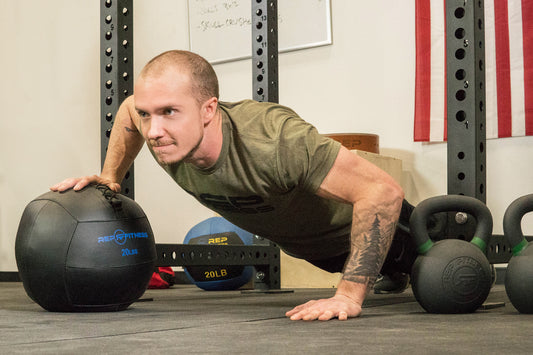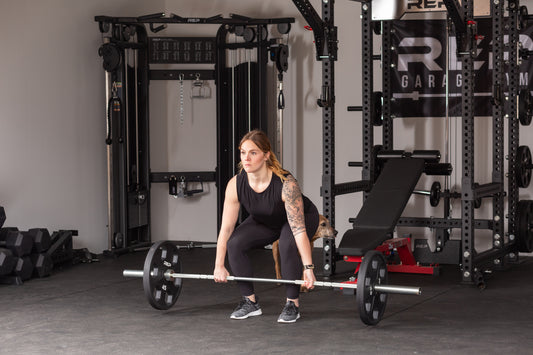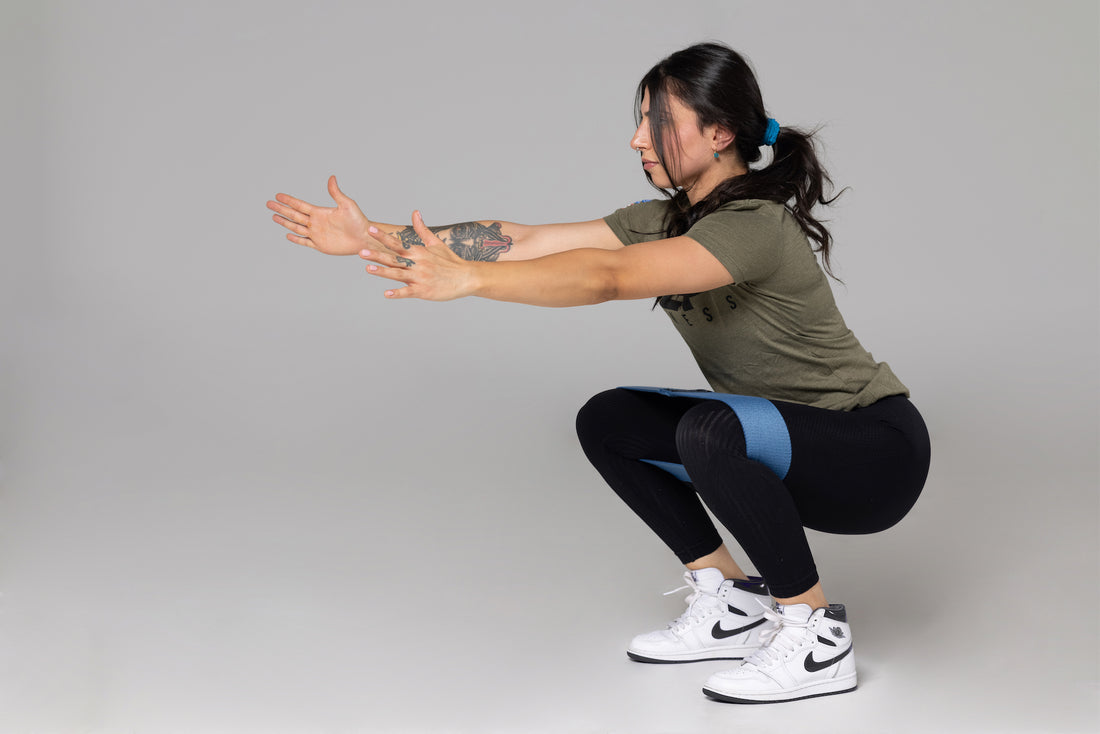
They check all the boxes: They’re versatile, compact, lightweight, inexpensive, and accessible to all levels. Exercise bands can be a key part in a quality home gym.
And while they’re easy to use, that first requires knowing what’s what -- about the different types of bands and their unique purposes. You don’t want to be doing band pull-aparts with a floss band or trying to do banded deadlifts with a hip circle; that would be an Armageddon-level disaster. If you could somehow pull it off. (Please don’t take that as a challenge to try unless you are literally Jujimufu. The rules don’t apply to him.)
Here’s a closer look at REP’s four different kinds of fitness bands and how to use them.
Pull-Up Bands

What are they? Stretchy, 38” long loops made from layered elastic. There are no handles. Width varies by size; the lighter-resistance band is thinner and the heavier-resistance band is wider.
Different options: Pull-Up Bands come in seven sizes with varying widths and colors. Bands start with XXX-Light (yellow), with a 0.25” thickness and 5-15lbs resistance, and they top out at X-Heavy (orange), which is 3.25” thick and creates 70-175lbs of resistance.
How to use them: As the name suggests, a popular usage is to assist with pull-ups. If you can’t do an unassisted pull-up, they can make it easier. And if you can, they can allow for higher volume. But that’s far from the extent of their uses.
You can attach resistance bands to band pegs on your power rack to create added or different resistance while weight training. This is especially helpful when training compound lifts. For example, attach the bands low and loop them around the ends of the barbell to help train your deadlift lockout by making the top portion of the lift the most difficult.
You can also get in a full-body strength-training workout with just resistance bands: chest presses, squats, curls, rows, you name it. And no, that’s not just an empty promise. A study published in the National Center for Biotechnology Information found that resistance bands had a similar effect on strength gains as regular gym equipment. Now, that’s likely not going to hold true for more experienced lifters and competitors, but for a new or average lifter, the important take-away is you can get in a good workout with bands.
The size variations of the Pull-Up bands are designed for different levels of fitness and purposes.
Short Resistance Bands
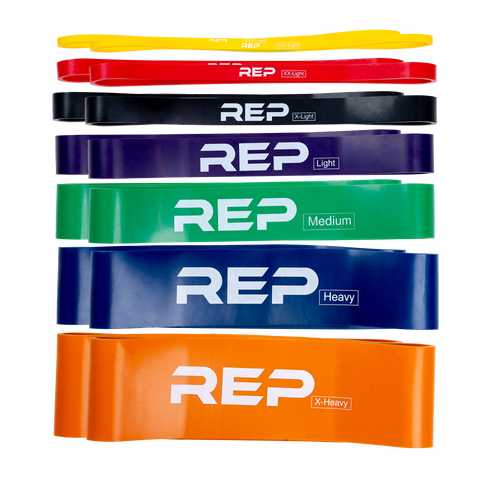
What are they? A shorter, 12” version of the standard 38” long Pull-Up Bands.
Different options: They come in seven sizes of varying resistance, width, and colors. Bands start with XXX-Light (yellow) with a 0.25” width and 5-15lbs resistance, and they top out at X-Heavy (orange), which is 3.25” wide and creates 85-230lbs of resistance.
How to use them: The size variations are designed for different levels of strength and purposes, such as training for a pull-up or providing an extra challenge on compound lifts. To add resistance while weight training, attach the bands to a cable machine or power rack with band pegs and then loop the bands around your barbell.
You can also use bands for accessory work, stretching, rehab, and warming up.The shorter length makes it easier to set them up and eliminates the need to double or triple up the band over pins or band pegs to get enough tension for banded lifts.
Tube Resistance Bands with Handles

What are they? Lightweight, portable bands featuring handles on either end. The handles give you something to hold onto while working out. These are not loops. They are all about 49" long (about 4').
Different options? These bands are offered in three different color-coded options, so you can quickly identify the difficulty levels. The blue band (9mm) is light resistance; the orange band (12mm) is medium; and the black band (13.5mm thick) is the heaviest resistance.
How to use them? Use the Tube Resistance Bands for strength training, stretching, physical therapy, rehab, and more. Because they aren’t a loop, these aren’t optimal for pull-up assistance or adding challenge to compound lifts.
But due to the easy-to-grip handles, these are ideal for resistance band workouts. The handles are more comfortable and easier to hold onto than just gripping the elastic on the Pull-Up Band. They also allow your hands to be in a more natural position than a loop-style band.
Circle Hip Bands

What are they? Shorter, wider, stretchy loops lined with grip strips on the inside of each band to prevent slipping and folding. They’re made from a thick polyester fabric, whereas the looped bands are only elastic. Circle Hip Bands are compact, at 3.2”(W)x12.5”(L). They’re much shorter than the other exercise bands.
Different options? These bands are available in three different resistance options and are color coded and labeled for easy identification. Light resistance is red, medium is black, and blue is heavy
How to use them? Circle Hip Bands can help you warm up, strengthen muscles, add resistance to lifts, and improve mobility and recovery. Per the name, these are especially designed for hip/glute/leg exercises.
Their shorter width fits around most people’s upper thighs (above the knees) to add resistance for exercises like squats, clams, lunges, “fire hydrants,” glute bridges, donkey kicks, glute kickbacks, leg lifts, monster walks, lateral band walks – all the leg day fun. The goal is to keep pushing outward when the band is trying to pull your knees inward.
Hip bands can also require some core engagement. Some lifters add them into weighted exercises (like leg press) for added challenge, too. Add resistance during squats, deadlifts, push-ups, and chest presses. Improve stabilization and mobility, as well.
Short Loop Bands
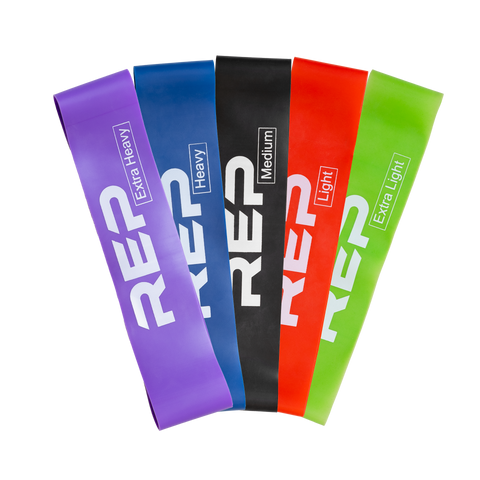
What are they? Latex or latex-free looped bands that are 9" long, 2" wide, and can stretch up to 2.5 times in length. While the Circle Hip Bands are also short loops, these are stretchier, not as wide, and made from a different material.
Different options: Five different resistance levels: extra light, light, medium, heavy, and extra heavy. They are sold as a set.
How to use them: This type of band is ideal for shorter, more targeted exercises. Use them to help you warm-up, strengthen muscles, improve mobility and recovery, and perform rehab work. You can also use these for similar exercises as the Circle Hip Bands, but they feel different and don't provide as much resistance.
Floss Bands

What are they? Long (7’), flexible bands designed to wrap around a muscle or joint to help with recovery and blood flow. These have no handles and are not a loop.
Different options? Floss Bands come in two sizes. The thicker red band (0.06”) is ideal for larger muscle groups and joints, while the thinner black band (0.05”) is better for smaller muscles and joints. Both bands are 7’ long and 2” wide.
How to use them? These aren’t for creating resistance, and they’re definitely not meant to assist your pull-ups. Floss Bands are designed to improve your mobility, blood flow, and recovery. Wrap a muscle or joint with a band, perform range-of-motion exercises for up to two minutes, and then remove the Floss Band. They can help with recovery in areas that foam rollers and lacrosse balls can’t reach.
By tightly wrapping the muscle and working the joint through a full range of motion for a couple of minutes, the friction between muscle fibers will help break up lactic acid, scar tissue, and other “junk” in the area. Upon removing the band, blood flows back to the targeted muscles, clearing out the area and bringing essential nutrients for healing. Use Floss Bands on your shoulders, arms, elbows, wrists, knees, hamstrings, calves, ankles, and feet.
